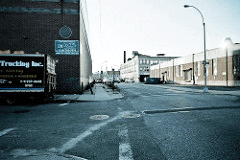In a recent blog post, Tarry Hum, a professor of urban studies at Queens College, profiled the failure of the De Blasio administration to preserve prime industrial spaces in the outer boroughs of NYC.
In particular, she noted the failure of the city’s industrial zoning regulations to limit industrial conversion to non-industrial uses. While we often assume the combination of mass deindustrialization and high land costs often preclude industrial employment, many of our major cities and metro areas remain centers of industrial production. Further, as Dr. Hum points out in her blog post, manufacturing remains one of the key pathways for poorer immigrant communities to claim a spot in many urban economies.
But until quite recently the question of industrial land provision and preservation has been largely ignored by economic development researchers and professionals. Generally, both land-use and economic development planners have generally treated industrial land as drags on a city’s tax rolls and near obsolete given an assumption of total domestic de-industrialization. But more critical economic development planners have started to question these assumptions.
Green Leigh and Hoelzel really brought this issue to light for many planners with their 2012 piece, “Smart Growth’s Blind Side” where they found that the Smart Growth manuals that many cities used either did not mention industrial land’s importance or actually framed industrial land as uniformly damaging to cities—both as drains on tax revenues and as sources of pollution. Leigh and Hoelzel go to pains to explain that industrial land is not only useful from a city management standpoint (after all, cities have to be able to store their vehicles and heavy equipment somewhere), but also that gleefully converting industrial land cuts off potential economic and community development opportunities for our cities.
The greater issue here is not a blind faith in the return of manufacturing to cities, but in not foreclosing legitimate economic and community development opportunities for the sake of converting land for its “highest and best use.” Conflicts over industrial land use within our cities are greater conflicts over what kind of economies we want present in our cities and who is able to take advantage of given opportunities.
Deliberately pushing out industrial use is not only shortsighted and inefficient, but limits opportunities for greater social mobility for working class and poor neighborhoods. We need smarter industrial land use planning now, especially in our fastest growing cities.
(Photo credit: By Chad Carpenter via flickr, CC BY-NC-ND 2.0)





I think you’re on to something here. I agree that manufacturing will see a resurgence in U.S. cities as labor laws become more stringent overseas and make it more palatable for domestic companies to return operations here, not to mention the growing trend of new startups whose mission includes creating local skilled labor employment.
Perhaps the challenge with industrial land is the very flat nature of their development, compared with other building types. In high-demand markets, the taxable value per acre is lower for a single-story warehouse than it would be for a multi-story mixed-use building.
Therefore, what I think we should be exploring further is mixed-use industrial properties. If we allow clean manufacturing to co-locate with office, retail, and/or residential uses, that could be a win-win for cities—especially if housing includes units that are affordable to those working in the manufacturing facility.
Thanks for posting this article about a vital and under-reported issue. A major reason that industrial uses have been largely ignored by the planning profession is that their inherently low-density character conflicts with the high density fixation of smart growth/TOD. There are other reasons as well, which I discuss in “Industry and the Smart City,” published in the summer 2009 issue of Dissent.
https://www.dissentmagazine.org/article/industry-and-the-smart-city
In the Bay Area, planners’ commitment to smart growth, politicians’ kowtowing to the real estate industry, and a runaway real estate market are forcing industrial businesses and their jobs to the region’s edges and beyond, worsening traffic congestion and air pollution (the trucks have to come back into the center), as well as diminishing middle-wage employment for people without advanced degrees. I’ve written extensively about the problem in San Francisco for 48 hills.org.
I disagree with the thesis based on Cincinnati’s West End and most of Detroit. Over development of industry is one of the primary reasons for Detroit’s decline- with roughly 60 auto manufactures at its peak down to just three today- what is to be done with all those brownfields?
And in Cincinnati, thriving communities were wiped out in the name of urban renewal for the sake of highways and industry. Is this really city building or should we relegate industry to the suburban and rural areas of metros like is done in the UK? Cities first and foremost need residents, not warehouses.